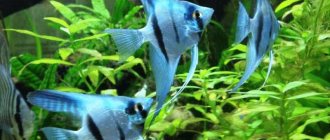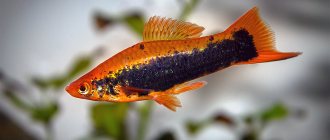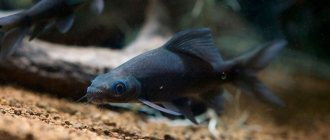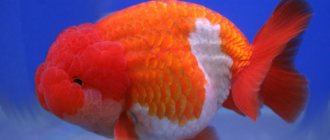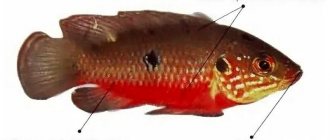5
(7)
Thanks to its endurance, interesting behavior and unpretentiousness in keeping, the Lineatus pike has become popular in the world aquarium hobby. The first scientific description dates back to 1846. At the beginning of the 20th century, the species appeared in German aquariums, where the experience of breeding at home was first established.
Conditions of detention.
To successfully keep fish, a relatively small aquarium is required, with a volume of 30-50 liters, it is important that it is not high. Maximum recommended height 30 cm but wide. The fish are very active, so they can jump out of the water, so the aquarium is covered with a cover glass. Water parameters: hardness 2–6°, pH = 6.5-7. Water temperature 20–25°C. It is recommended to put fish in old water, the active medium is acidic. It is recommended for these purposes to use peat, from which a tincture is prepared and added to water. Or a piece of peat is placed in the section of the hanging filter. Aeration and filtration are not of great importance.
The soil is coarse sand mixed with peat. Plants with a well-developed root system are planted in the aquarium. Capable of creating a natural shelter for fish. If pike are kept with other fish, then it should be larger in size. Small fish are attacked by jokers. Feed. Small bloodworms or other small live food. At 5-6 months, the fish is capable of reproduction; for this purpose, an all-glass container of 15-20 liters is taken, and soft, slightly acidic water with a temperature of 28C is prepared. One male and two females are placed for spawning. Spawning lasts 5-8 days. After 2 weeks, larvae emerge from the eggs and immediately need to be fed with Artemia naupia. After 2-3 weeks, the fry are sorted. Fish in an aquarium live for several years.
Asian pike
Feeding and diet: Feeding of any aquarium fish should be correct: balanced, varied. This fundamental rule is the key to the successful keeping of any fish, be it guppies or astronotuses. The article “How and how much to feed aquarium fish” talks about this in detail; it outlines the basic principles of the diet and feeding regime of the fish.
In this article, we note the most important thing - feeding fish should not be monotonous; the diet should include both dry food and live food. In addition, you need to take into account the gastronomic preferences of a particular fish and, depending on this, include in its diet food either with the highest protein content or, conversely, with plant ingredients.
Popular and popular food for fish, of course, is dry food. For example, all the time and everywhere you can find food on aquarium shelves - the leader of the Russian market, and in fact the range of food from this company is amazing.
Tetra’s “gastronomic arsenal” includes individual food for a specific type of fish: goldfish, cichlids, loricariids, guppies, labyrinths, arowanas, discus, etc. Tetra has also developed specialized foods, for example, to enhance color, fortified, or for feeding fry.
Behavior of the aquarium pike
A representative of the carp-toothed family does not behave aggressively towards its own kind, but can eat fry if it is very hungry. It is kept in the same aquarium with barbs and cichlids. A well-fed lineatus does not pay attention to the fry.
The peculiarity of this freshwater fish is its large mouth . When you need to catch a fry, the pike hides in a nook of the reservoir. She attacks when prey swims close. Before grabbing the fry, the pike presses its tail, then straightens it and jerks. It is not recommended to keep Lineatus with small fish, as they can be eaten.
The female can be very active. To catch an insect, she literally jumps out of the aquarium. Thanks to its developed fins, it easily pushes off and attacks.
It is not recommended to place small fish in an aquarium pike.
Appearance and gender differences.
Lineatus in appearance resembles a small pike, only it is up to 10 cm long, has a flat body, turning into a head with an elongated large mouth. The eyes are large, green, and the fins have the same arrangement as large pikes. The color of the male's body is yellowish-brown, and the body is decorated with rows of golden-green dots. The chest is dotted with red specks. The fins are decorated with golden dots and streaks. Thoracic and abdominal are yellow. The golden and green forms of lineatus are also distinguished. According to sexual differences, females are larger than males, and the color is not so bright; females have a dark spot on the dorsal fin. Upon reaching sexual age, breeders should develop dark transverse stripes on the back half of the body.
Asian pike
DESCRIPTION
The homeland of these fish is Southeast Asia, where they inhabit fresh water reservoirs. These fish were brought to Russia in 1903. Today they contain four species of Asian pike.
Nutrition
Lineatuses are not picky when it comes to nutrition. But since in the natural environment they feed on small fish, insects and their larvae, then at home the basis should be protein food.
This:
- Live food (tubifex, bloodworms, brine shrimp, etc.);
- Pieces of sea fish meat;
- Feeding insects;
- Dry fortified flakes and granules.
These fish are prone to obesity, so it is recommended to do a fasting day once a week. It won't hurt them. It is better to underfeed Lineatus than to overfeed it.
Habitat.
Lineatus (A. lineatus). The homeland of the fish is Hindustan, Sri Lanka. Panchax (A. panchax) Homeland - reservoirs of Hindustan, Sri Lanka, islands of the Malay archipelago. It differs from Lineatus in body structure and coloring, but the conditions of detention are similar. Aquarists also keep Aplocheilus Dey and Madras Aplocheilus. But they are not very common, and their conditions of detention are similar to those described below.
COMPATIBILITY WITH OTHER FISH
Peaceful predators do not touch other fish, provided that they are large enough not to be considered as prey. They can arrange small skirmishes among themselves; it is better to keep at least 4 individuals. However, skirmishes do not harm the fish. Well suited for keeping with fish of the same size, but what you should avoid are small fish. For example, they will consider zebrafish, cardinals, rasbora, microrasbora galaxy and neons as food.
Asian pike
BREEDING
Pike are bred quite simply. During spawning, which can last daily for a week or more, the pair lays 50 to 300 eggs daily on small-leaved plants or cleared surfaces.
The thickets of plants on which they lay eggs must be replaced daily with others. This could be a bunch of moss that needs to be moved to an aquarium with the same water parameters as in the spawning tank. The fry fully develops within 12-14 days. First, a larva appears, which consumes the contents of its yolk sac for a long time, and then begins to swim and feed. Starter food for Artemia naupilia, or egg yolk. Some fry grow faster and may eat their brothers, so they need to be sorted.
Compatibility with other fish
The best solution would be a separate species aquarium with common horny snails. These mollusks will benefit from ammonia, ammonium compounds and nitrides, which are very harmful to the health of lineatus. Intraspecific conflicts will be minimal with a slight predominance of females in the flock.
The selection of neighbors in a common aquarium must be approached responsibly. Smaller fish with veiled tails and fins should be excluded from their neighbors. Neons, danios, tetras and guppies can become food for adult lineatus. But large, aggressive Acara and Astronotus cichlids will prey on young pike. Neighborhood with very active individuals threatens that Lineatus will remain hungry.
A peaceful existence with mollies, barbs, large swordtails or rainbowfish is possible.
Comments 7
Only users with a rating above 20 can see the voting results (who voted and how).
Voted for: founder
Voted against:
for fun.
Let go?
Only users with a rating above 20 can see the voting results (who voted and how).
Upvoted by: founderPiton2
Voted against:
Fuck it. Ate it all.
This is the case when the pike doesn’t mind either.
They mixed things up along the way: they promised to love princesses, not to catch them.
A little confusion in this matter will not hurt.
Commenting is available only to authorized users.
Despite the exotic and decorative appearance, various predatory fish can also exist in aquariums. Of course, with appropriate neighbors and proper nutrition.
These individuals also include aquarium pikes, the species of which are diverse.
Afiosemion
For the existence of these representatives of the nothobranchiaceae family, they need a lot of vegetation and shelters from snags and stones. They are peaceful and can get along with relatives of similar sizes.
All Afiosemion breeds are multi-colored with a predominance of a particular color. They feast on live food, but can also eat frozen food.
The acidity of the water in which these fish breeds are kept is 5.5pH - 7.2pH, and the hardness is 6gH - 15gH.
There are significantly more females in the aquarium than males, their approximate ratio is 3:1.
Nothobranchius
This seasonal Killi Fish lives for about 12 months. To maintain the population, they need to be constantly bred. The fish get along well with other aquarium mates.
Nothobranchius prefer to swim on the surface or in the middle layers of the aquarium world. A deep and richly planted aquaworld is most suitable for them. Small “fights” between males may occur.
Nothobranchiuses are distinguished by their brightly colored scales. Among them there are individuals with a predominance of turquoise, red, green or purple colors.
Pike feed exclusively on live and frozen food. The most optimal water temperature in the aquarium for nothobranchius is 22–25 degrees.
Description
The golden lineatus is a small fish that grows up to 10 cm in length and can live in an aquarium for up to 4 years.
The body is elongated and slender, with a slightly stooped back. The head is flattened at the top, with a pointed muzzle and mouth turned upward.
The natural color is much more faded compared to the one that gave lineatus its popularity - golden (gold form).
This color, of course, does not occur in nature; a fish so bright simply cannot live long. But, in general, in terms of maintenance and care, such fish do not differ from those painted in natural colors.
The body is bronze with small bronze scales, and closer to the tail there are several dark vertical stripes. But, using the method of selection, it was bred to look like the fish we know now - golden in color.
Common pike
This is the most common species of predatory fish that can live in aquariums. In freedom it reaches 120 cm, and in captivity it is small - about 60 cm.
The fish has hard, armor-like scales, which is why it is also called armored pike. The predator's body is elongated, with sharp teeth on its powerful jaws. A distinctive feature is the vertebrae, which have a depression on only one side. The opposite side is convex, like that of amphibians. Breathing occurs through the swim bladder.
When keeping, the most important thing is the water temperature, which should not exceed 18-20 degrees, otherwise the fish may die.
You cannot keep armored fish in aquariums smaller than 150 liters. This leads to the fact that the individual begins to gain weight and its size decreases.
A selection of photographs of lineatus
Lineatus photo
Lineatus photo
Lineatus photo
Video with lineatuses:
Only users with a rating above 20 can see the voting results (who voted and how).
Feeding your pet
The carp-tooth has a developed jaw. He willingly eats:
If you introduce fry into the aquarium and do not give other food, it will feed on them. Pike respond well to dry food. You can give her cereal. In order for a freshwater resident to receive valuable substances, you need to feed it with crushed bloodworms .
Lineatus is prone to gluttony, so you should give him food in moderation.


